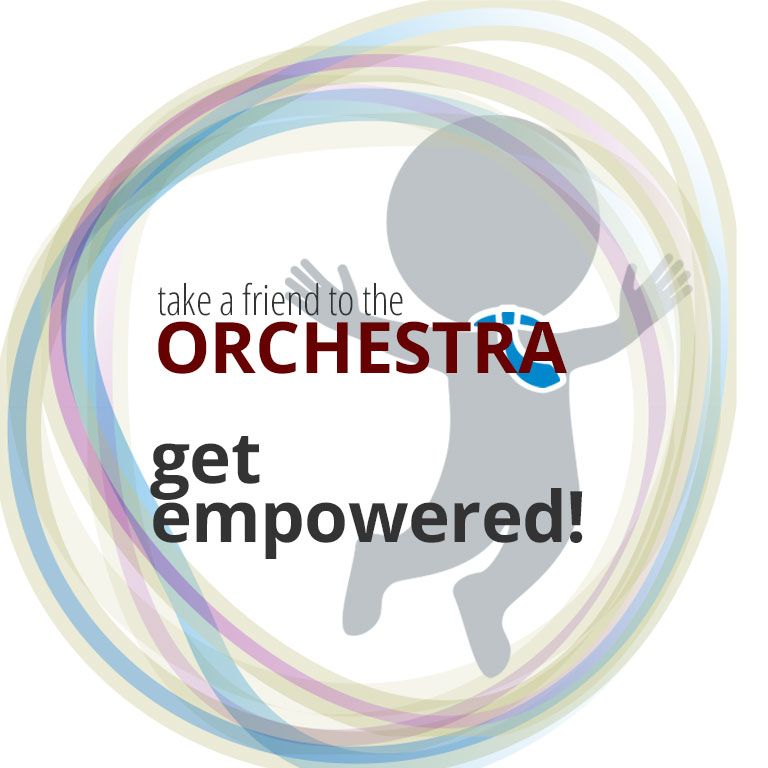If you want a preview into the world of mainstream music journalism all you have to do is start reading Marc Geelhoed. Marc is one of the most entertaining, perceptive young cultural writers around today.
Based in Chicago, he consumes a regular well balanced diet of classical music events and has something unique to say about them at his Time Out Chicago column. If that weren’t enough, Marc also maintains a blog aptly named Deceptively Simple which tunes a finely tuned ear to the Chicago arts scene (literally; check out the “overhead” segments, you’ll love them)…
TAFTO Contribution
By: Marc Geelhoed
A recent cartoon in The New Yorker showed two men wearing business suits, one standing up, the other seated behind a desk. “Christianity isn’t the only thing that needs evangelists. So does big oil,” the seated one says. While none of the Take a Friend to the Orchestra contributors thinks of themselves as lobbyists for classical music, we are, in a way. But we have the benefit of advocating for an art form whose continuity we care about, and any money we happen to pull down from our employers is almost incidental. We also tend not to be subpoenaed.
As part of my evangelism–the good-natured, non-confrontational kind–I’m here to help you help a friend get the most enjoyment from their first trip to the symphony. As with all first experiences, the first time tends to be a disaster. But because you know so much about your local orchestra and classical music, the chances for success are much higher.
Let’s start with that local orchestra. You’ve heard them play everything from Beethoven to Bach transcriptions to Stravinsky to works by living composers. You know the players’ strengths and know which composers’ music they play as if they enjoy it, and which composers’ they don’t. If you’ve never heard them really lay a Shostakovich climax on the line, then the Shostakovich Fifth Symphony they have coming up probably won’t be the best introduction to the concert-going experience.
But if the Mozart symphonies and piano concertos you’ve heard them play were filled with whip-smart phrasing from each section, that’s the ticket you want to buy. Hearing your orchestra’s tight-knit strings, your concert companion will likely enjoy themselves and the music much more than when that same string section just can’t give Shostakovich the heft he needs.
Since you’ve been able to hear each of these musicians over the years, you know their strengths and weaknesses almost as well as they do. Use that knowledge to help your friend. If your orchestra’s principal flutist is a stunner, then that concert with Debussy’s La Mer will probably impress your friend. And if the brass likes to trample over every other section, then the Mahler First Symphony concert could be an eye-opening evening.
The other knowledge you have is of the orchestral repertoire itself. What got you interested in it all those years ago? I look for works for first-timers that are impolite and have big climaxes that can’t possibly be missed. Prokofiev usually fits the bill.
I took a circuitous path through Mahler, Beethoven, Stravinsky, Boulez and Shostakovich to become a seasoned orchestra fan. It wasn’t through Haydn and Mozart. They just sounded too predictable, mainly because I didn’t know how to hear their surprises. Many of today’s listeners, reared on rock, jazz, Philip Glass and African drumming also need some time to find the surprise in Salzburg’s favorite son. Find whatever first interested you, and if you are still passionate about it, you’ll be able to communicate it that much more easily to your friend. You may have lots of fascinating stories of playing Mozart’s symphonies in college; use them to your advantage.
If you’ve followed these steps so far, you’ve thought about which sections of your orchestra are the strongest and which composers you would like to use to introduce your friend to the orchestra. Now you get to introduce your friend to the music prior to the concert.
Two or three weeks before, give your friend a CD of the big work on the program. Tell them just to put it on in the background while they unload groceries or wash the dishes or help with their children’s homework. If they don’t have kids they’re helping in the evening, suggest that they play the disc and read a magazine instead of watching TV. Make it clear you don’t expect them to stare at the walls as they listen.
There’s no need to give them a history lecture on how Beethoven straddles historical styles or how Mahler’s Sixth Symphony is the only one of his symphonies in which he repeats the exposition. Critical listening can come later.
If they listen to the CD three or four times, they will absorb all the big melodies and loud parts by the time the concert rolls around. During the concert, those moments will serve as tent-posts they can string the rest of the work on as it progresses. The quiet parts they missed when the CD was playing in the background? Your friend will be astonished at what they missed and by what they had no idea to expect.
Treat going to the concert like going to a baseball game. Get there early, and instead of watching batting practice, watch the musicians warm up. By telling stories about these players, you’ll bring them into your friend’s orbit. Tell them about the amazing duets you heard the oboist and flutist play in Beethoven’s Seventh Symphony last year. Tell them about how loudly you heard that percussionist hit the bass drum in Verdi’s Requiem. That phrase the principal horn-player keeps repeating? That’s in the big piece on the second half, and your friend will probably appreciate knowing that these players are human, and like–need!–to practice up to the absolute last minute.
While you can watch the pre-concert warm-ups like a baseball game, you probably shouldn’t suggest your friend wear what they would to the stadium. I wear jeans because they’re comfortable and no one seems to mind. But if your friend feels like getting a little more dressed up, let them. If they want to throw on jeans and t-shirt, that’s cool, too, but you should drop a small hint that maybe they should spiff up the ensemble with nice shoes.
Then again, a friend of mine who regularly goes to the Chicago Symphony last showed up in a long-sleeved shirt that looked suspiciously close to long underwear underneath a polo shirt and a vintage tie. No one batted an eye.
Newcomers often complain that an orchestra looks like a passionless bunch of robots, so suggest that your friend watch a single musician for a few minutes at a time. Look closely and you’ll see the clarinetists swooping their instruments along with a melody, a back row violinist smiling (it does happen), and the brass players shuffling their feet to congratulate a trombonist’s well-played solo. By watching an individual for minutes at a time, these subtleties will become much more apparent. (I recommend finding the most attractive woman to look at, but your friend can adjust to their preference.)
Go have a drink after the concert. If your friend is the type that prefers a swanky place, go there, or if a dive bar is more their speed, head there. Your goal isn’t to turn them into old-money concertgoers, but to help them appreciate the orchestra on their own terms, so let their comfort zone work in your favor.
Ask how the concert fit with their expectations. Find out how the performance sounded to them after they’d been listening to a recording. Did it sound familiar or like an entirely new version? Ask them which solos they remember. Did they like hearing one musician or section better than another?
If they were bored, what caused that feeling? Was it the music, the performers, the atmosphere, or something else? If it was a dreary performance, then your friend’s boredom is justified. But if it wasn’t, find out what they heard that you didn’t. Tell them where the excitement you heard started from, whether it was the brass or how the conductor drove the players to the end of the movement. If your friend was nodding off in the slow parts, explain how it’s the way the melodies get passed from section to section that keep those languorous passages interesting.
If it was the atmosphere that they found stultifying and condescending, insist that they ignore it. Every music scene has its annoying members of its crowd, and those who insist that everyone treat the concert hall as a temple are classical music’s.
These few tools should give you a head start on inviting a friend along, and just might help them enjoy their first time even more. As we all know, the more you like something, the more likely it is that you will do it again.



I can’t agree with Geelhoed about much that he says here. Then again, I’m not an advocate of “anything goes” in dress at an orchestra concert.
Listening to a piece of music casually, as wallpaper, as Geelhoed suggests one prepare, is idiotic.
Why does your guest writer approach the whole process always trying to minimize the effort and work involved for a new listener. It’s as if he tells us —-this is all the effort needed!
Anything’s cool man!
I find his suggestions banal and obvious.
Georg, thank you for taking the time to send in your note, however, I sincerely disagree with you on this issue. Allowing the listener to decide how they want to experience a concert on their own terms is one of the greatest signs of respect and inclusion an orchestra can offer their patrons.
I have yet to meet a listener who experiences every concert the same way year after year. As such, as time passes it’s likely that the way they experience a concert event will evolve, as does any passion in life.
Furthermore, I think the tone of your comment was unnecessarily inconsiderate although you certainly have a right to view your opinions here at Adaptistration any way you wish.
I think there are so many ways for people to enjoy a concert. To criticize one person’s ideas on how to enjoy is silly. How do you tell someone to enjoy ice cream. Maybe the way I like to eat it or serve it is banal and obvious, but maybe someone else would have a whole new perspective of it.
As fun as it is to bring a first-timer to the symphony, I hope orchestra staff members can also participate in TAFTO–by clearing the schedule to bring themselves to a concert or two in a non-working capacity! Running around backstage to find the missing drummer, or gently preventing your photog from wandering out into the center aisle during the first movement, or standing at the entrance of your green room reception feeling like a glorified bouncer … None of these chores are conducive to remembering the excitement of a live performance and your reason for taking the job.
I once gave an extra ticket to a concert by the Israel Philharmonic to a man standing in line at Orchestra Hall in Chicago. It turned out he was an Australian pilot on vacation and lived in Hong Kong. After Andre Watts played the Emperor Concerto, the pilot turned to me and asked, “What does this mean?” pointing to “Rondo: Allegro non troppo” in the program. I explained that a Rondo is a five- or seven-part form that’s usually humorous and usually comes at the end of a work to give it a happy ending. Perhaps, “Georg,” the pilot would have gotten more out of the concerto if I had given him a music-theory lecture beforehand. But it was the experience itself that made him ask a deeper question, and which gave him enough pleasure to want to know more. Had he been expected to know what a Rondo was, I doubt he would even have accepted the ticket. Please don’t call my ideas “idiotic.” The idea that there is effort that is “needed” is one that keeps more people away from classical concerts than you can possibly imagine. If newcomers latch onto it, they’ll want to make the effort you so highly value. But if they aren’t grabbed by the experience itself, no homework assignment is going to prove to them that they should be enjoying themselves. They’ll just feel stupid. And they won’t come back.
APOLOGIES, I can’t figure how to make paragraph breaks on this board. “The idea that there is effort that is “needed” is one that keeps more people away from classical concerts than you can possibly imagine”
Is that really so controversial or debateable? 98% of my friends and acquaintences really only listen to music that is
a) under 5 minutes long
b) has vocals in English
so I don’t think it’s too much of a stretch to think that listening to an hour long symphony is going to “require” or “need” effort.
I often get the feeling that it’s one way traffic when it comes to audience building: the orchestras have to jump through hoops to present the experience in a “listener friendly way” (Singles Night at the Symphony! Short Pieces Only! Nothing That Would Offend People Who Find Pink Floyd Difficult!) but heaven forfend that the potential audience member have to do anything other than grace the Disney Hall or wherever with their presence (and credit card!).
I simply think that it’s a form of lying to pretend or sell the experience on the basis that the music is immediate and easy to grasp, that it requires concentrated listening. I mean, I’ve been listening to classical music as long as I have memories (thanks Dad) and some pieces such as Birtwistle’s “Earth Dances” have taken over 50 or so listens with a score in hand to “get”. Now, a Mozart piano concerto is much easier to grasp than Stockhausen’s “Gruppen” but I certainly had no problem with putting in an effort. I find that there’s a real arrogance and narcissicism about consumers of cultural — low, middle, high — things these days, a kind of “We know you’re desperately chasing our dollars, now kiss our ass or we won’t bother with you” that I find really distasteful.
To be honest, whenever I have someone express interest in getting in to the symphonic rep, the first thing I tell them is “If you want to *get* the music, it’s going to take time and it’s going to require patience, this isn’t the latest Green Day album”*. I tell them “the music IS complex, it IS long, it IS hard to grasp sometimes even after 20 listens”. Some see it as a challenge, some don’t want to bother.
That said, I think your post was common sense, not banal. I used to be a real advocate, I’d hector people about how great the War Requiem is. Now, I just make mix-CD’s of pieces and point them to websites that Explain It All to them, which are legion. The first time I listen to a new piece that I’ve heard good things about, I’ll plant my head between the speakers and totally focus, but after that, I’ll use it as dishwashing music or whatever until I know the piece well. When I first got in to opera, I’d listen to “Peter Grimes” or “Das Rheingold” as I was falling asleep, maybe an LP side’s worth.
I live in Los Angeles, so it’s pretty casual dress at the Disney Hall (for me: nice pair of black jeans, a collarless longsleeve shirt, nice shoes). I’m just baffled at how big an issue this seemingly is; I certainly wouldn’t show up in a suit and tie for a punk show. People certainly don’t seem to have a problem dressing in work casual at least for a play. Another common complaint is “I got ‘shussssshed’ for talking’. Well, talking after the music starts is a no-no, full stop, which should be obvious to the person doing it because no one else is talking. It’s very simple: to hear the nuances of the performance and, in the quieter bits, the music itself, having John and Jane Doe nattering on about how stuffy the players are makes me want to smack them. It’s called reading a social setting: if I go to a church to hear gospel, I wouldn’t think for a second of wearing tails and sitting there quietly with my hands folded in my lap.
As for the players not emoting, WTF? I mean, WTFF? People are so weird–do they expect the concertmaster to be acting like Pete Townshend of The Who ca. 1970? I seem to remember no complaints about The Cure coming on stage in the early 80’s and standing stock still except for the movement of their arms, not twitching a face muscle, for a whole set. No, The Cure were “moody” and “dark” and “intense” but violinists playing music a thousand times more difficult than “Let’s Go To Bed” are stuffed shirts who are “elitist”. WTFFF?
* I like Green Day